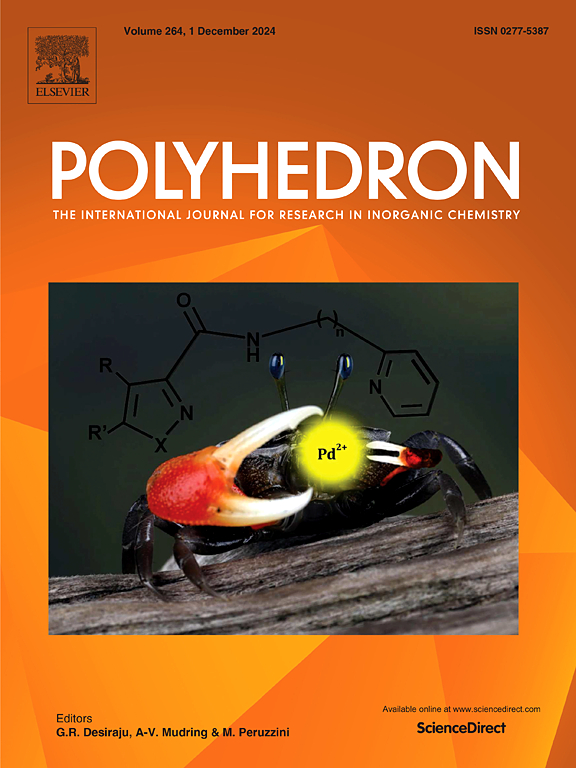钌- TiO2敏化剂的化学修饰:通过计算方法对DSSCs中电子转移和光捕获的影响
IF 2.4
3区 化学
Q2 CHEMISTRY, INORGANIC & NUCLEAR
引用次数: 0
摘要
染料敏化太阳能电池(DSSCs)中的化学修饰,包括使用各种锚定基团,可以增强半导体衬底上染料敏化剂的吸收。这有利于从敏化剂到半导体的有效电子转移,激活太阳能电池。本研究旨在研究设计的四种钌敏化剂在气相和乙腈溶剂中与(TiO2)8簇结合和不结合的结构、电子和光学性质,以评估它们在DSSCs中的潜力。钌(II)敏化剂是在参考染料D0的联吡啶(bpy)配体上由肟(D1)、羧酸(D2)、苯二酮(D3)和膦酸(D4)等锚定基团修饰而成,其性能发生了变化。其中D3由于能隙较小,表现出较好的反应性和稳定性。采用时相关密度泛函理论(TD-DFT)模拟对关键参数进行评估。特别是,D2在UV/Vis区域表现出增强的光收获,表明载流子生成得到改善。此外,改变锚定基团对分子内电荷转移、光吸收和能级有积极影响,可能会提高DSSCs的光伏性能。染料在(TiO2)8表面的吸附研究揭示了强化学键,这对未来开发高效的DSSCs用Ru(II)染料具有重要的实际意义。本文章由计算机程序翻译,如有差异,请以英文原文为准。

Chemical modifications of ruthenium- TiO2 sensitizers: implications for electron transfer and light harvesting in DSSCs via computational approach
Chemical modifications in dye-sensitized solar cells (DSSCs), including the use of various anchoring groups, can enhance the absorption of the dye sensitizer on the semiconductor substrate. This facilitates efficient electron transfer from the sensitizer to the semiconductor, activating the solar cell. This study aims to investigate the structural, electronic and optical properties of four designed ruthenium sensitizers with and without binding to (TiO2)8 clusters in the gas phase and acetonitrile solvent to evaluate their potential in DSSCs. The Ru(II) sensitizers, obtained from the modification of anchoring groups including oxime (D1), carboxylic acid (D2), phendione (D3) and phosphonic acid (D4) on the bipyridine (bpy) ligand of the reference dye D0, showed variations in properties. Among them, D3 exhibited superior reactivity and stability due to a smaller energy gap. Time-dependent density functional theory (TD-DFT) simulations were used to evaluate key parameters. In particular, D2 showed enhanced light harvesting in the UV/Vis region, indicating improved carrier generation. Furthermore, changing the anchoring group had a positive effect on intramolecular charge transfer, light absorption, and energy levels, potentially enhancing the photovoltaic performance of DSSCs. Investigation of dye adsorption on the (TiO2)8 surface revealed strong chemical bonding, which has promising practical implications for future development of efficient Ru(II) dyes for DSSCs.
求助全文
通过发布文献求助,成功后即可免费获取论文全文。
去求助
来源期刊

Polyhedron
化学-晶体学
CiteScore
4.90
自引率
7.70%
发文量
515
审稿时长
2 months
期刊介绍:
Polyhedron publishes original, fundamental, experimental and theoretical work of the highest quality in all the major areas of inorganic chemistry. This includes synthetic chemistry, coordination chemistry, organometallic chemistry, bioinorganic chemistry, and solid-state and materials chemistry.
Papers should be significant pieces of work, and all new compounds must be appropriately characterized. The inclusion of single-crystal X-ray structural data is strongly encouraged, but papers reporting only the X-ray structure determination of a single compound will usually not be considered. Papers on solid-state or materials chemistry will be expected to have a significant molecular chemistry component (such as the synthesis and characterization of the molecular precursors and/or a systematic study of the use of different precursors or reaction conditions) or demonstrate a cutting-edge application (for example inorganic materials for energy applications). Papers dealing only with stability constants are not considered.
 求助内容:
求助内容: 应助结果提醒方式:
应助结果提醒方式:


